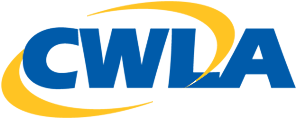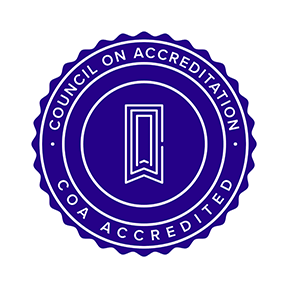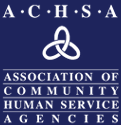Performance and Quality Improvement
An organization-wide Performance and Quality Improvement system advances efficient, effective service delivery, effective management practices and helps the organization achieve strategic and program goals. The organization’s leadership is committed to fostering a culture of excellence and continual improvement. This commitment is evidenced by using quality improvement results to build capacity and improve practice, allocating resources for an organization-wide PQI system and using data to make informed decisions. The agency further demonstrates its commitment by employing a Quality Improvement Coordinator who collects and analyzes data and monitors performance and quality improvement initiatives. The Director of Quality Assurance and Compliance conducts quarterly reviews of all programs to ensure adherence to Federal, State and local regulations and that the improvements made through the PQI process are put into practice and maintained.
Strategic Plan
2022 - 2026
1. Executive Summary
On March 23 and 24 of 2022, the Strategic Plan for the next four years was developed. The choice was made to aging the Strategic Plan with the four-year accreditation cycle to streamline the benchmarking and reporting processes. Pre-planning activities began in early January with targeted surveys being sent to staff and stakeholder groups. On the first day of planning, staff members from each site and all levels of the organization met to review the State of the Agency report and the agency’s mission, vision, and values statements. The group also defined the agency’s Strengths, Opportunities, Aspirations and Results (SOAR).
On the second day, board members, executive leadership, program managers and representatives of Trinity’s Diversity, Inclusion, Value and Equity (DIVE) Team met to develop goals, objectives and strategies intended to guide the agency through the next four years. The final results of the 2018-2022 plan were discussed and used as a baseline for determining which previous objectives were satisfactorily completed, which were no longer relevant, and which would be continued in the new plan period.
The team decided to keep the current mission and revise the vision statement to reflect the strongly felt belief that our primary vision is an extension of our mission and our desire to improve the lives of the children and families we serve. The values statements remained intact, and two statements were added. The team reviewed the national and state drivers influencing the future of the agency with the intent of continuing the agency’s philosophy of being proactive, rather than reactive in its short-term and long-range decision-making.
2. Authorization
The Board of Directors adopted the 2022 – 2026 Strategic Plan on April 29, 2022, by special electronic vote. This vote also included the adoption of the 2022-2023 Action Plans.
3. Mission
Helping children and families create a better future.
Vision
To cultivate an environment of compassionate quality care.
To plant seeds of hope and resiliency.
To nurture the development of children and families empowered for success.
4. Statement of Values
We value safety, well-being and permanency for children, youth, and families.
We value embracing research, best practices and proven approaches that help children and youth.
We value employees and will provide them with the knowledge, skills, and tools to be successful.
We value the ability to adapt and change to the needs of those we serve.
We value open, honest, and transparent governance and management practices.
We value Diversity, Inclusion and Equity in all we do.
We value the relationships with all stakeholder groups that enable us to do this good work.
5. Organizational Profile and History
Trinity Youth Services was established in 1966, by two Orthodox priests in Yucaipa, California. Although not affiliated with the church, the agency retained close ties for many years. Originally established as Guadalupe Homes and then later as Trinity Children and Family Services, before becoming Trinity Youth Services, the agency began with a six-bed group home that served delinquent youth. Over the years, the group home program grew and evolved into residential treatment programs. Later, the agency established a foster family agency, an adoptions agency and mental health programs.
Today, Trinity operates three Short Term Residential Therapeutic Programs (STRTP) for male residents between the ages of 12 and 17, and for non-minor dependents as well, generally from the ages of 18 – 21. The residential program treats youth who are placed by either department of children’s services or probation departments. The youth generally are those who have presenting pathologies as identified using the Diagnostic and Statistical Manual of Mental Disorders, 5th Edition. Many clients present multiple disorders that can include post-traumatic stress disorder, depression, emotional disturbance, substance-related and addictive disorders, oppositional behaviors, attention issues, impulsivity problems, and personality disorders. Individual and group therapy mental health services are provided to the residents. Permanency, safety, and well-being are the main goals of the program.
Trinity Foster Care was established in 1984 and serves foster children, birth to 21 years of age, and foster parents in three offices, two in California and one in Texas. The clients served are children who have been removed from their homes by child protective services and are wards of the court. A foster child adoptions program was established in 2011. Mental health services and Intensive Services Foster Care (ISFC) are provided to those clients who are identified as eligible. Permanency, safety and well-being are the main goals of the foster care program.
6. Organizational Mandates
The State of California enacted AB 403, the Continuum of Care Reform Act (CCR) in 2017. Coupled with the federal Family First Preservation Services Act (FFPSA), signed into law in 2018, these mandates encompass wide-ranging reforms to the delivery of child welfare services in the United States. Trinity was at the forefront of the reform movement in California, having qualified to begin implementation prior to many other providers by becoming accredited before it was required, having mental health program approval, Medi-Cal Certification and, gaining early approval for new Plans of Operation and Program Statements in order to become licensed under the new Foster Family Agency and Short Term Residential Therapeutic Program licensing standards. CCR and FFPSA mandates are a major driving force behind this Strategic Plan as the agency continues to conform to legislative updates and CCR and expand its array of services to accommodate FFPSA’s focused shift away from congregate care and toward to prevention services.
Another legislative mandate accompanied the passage of FFPSA. The Institutions of Mental Disease Exclusion of 1965, which prohibited the use of Medi-Cal funds for adults being treated for serious mental illness and substance abuse disorders in facilities with more than 16 beds. In 2018, this exclusion was expanded to include children in Short-Term Residential Therapeutic Programs (STRTP). This requires Trinity to reduce its capacity from 135 beds among its three STRTP campuses to 48, to remain at 16 beds at each campus.
COVID-19 and its variants have also prompted a slew of local, state, and federal mandates, directives and guidance that have imposed changes to the way the agency operates. The pandemic has made “flexibility” and “agility” necessary provisions to be included in any planning process.
Internal mandates are another driving force of the plan. PQI initiatives have driven efforts to consolidate operations, eliminate some operations, increase other services, and put a greater emphasis on training, outcomes, performance improvement and quality assurance. Outcomes are now driving county contracts and placements. Only through continuously improving performance, ensuring quality and encouraging innovation, will the future of the agency mission be assured.
Over the past decade, Trinity has adopted new approaches to trauma-informed care that have strengthened the culture of the agency. The agency has also adopted a parallel practice to trauma-informed care for employees, “Supervision for Success.” Just as trauma-informed care is the polar opposite to control and compliance approaches, Supervision for Success is at the opposite end of the spectrum of the traditional progressive disciplinary model for staff. Aligning these positive-reinforcement models and introducing the use of the SOAR approach to strategic planning have made a marked difference in the environments, attitudes, and outcomes of the agency.
7. Strengths and Opportunities
During the agency’s strategic planning sessions, the team came up with a very long list of strengths that position Trinity Youth Services to meet and exceed the standards of excellence established in the field of children’s services. While it is well understood by all members of the agency that we can never “rest on our laurels” and a strong commitment to continuous quality improvement is necessary to remain a leader and change-agent for children, the following is a list of strengths that have been lauded by clients, staff, contracting and oversight entities and additional stakeholders:
1. Trinity keeps its promises. This strength is supported by the following attributes:
a. Staff Experience and Longevity – as evidenced by more than 90% of supervisory positions being filled by internal promotions, and more than four years’ average tenure (all positions, aggregate).
b. Staff Expertise – as evidenced by more than 90% training compliance, staff retention of training materials learned, training questionnaires, and performance observations (internal and external)
c. Mission-Driven Decision Making
d. Commitment to Quality – as evidenced by internal and external audits, low incidence of investigations by licensing entities, efficacy ratings, and child/family outcomes.
Staff descriptors: History, Knowledge, Reputation, Longevity, Experience, Expertise, Continuous Quality Improvement, Quality.
2. Trinity is a strong, values-based organization. This strength is supported by the following attributes:
a. Collaboration – Trinity values collaborative partnerships and understands that together we are stronger than we are alone.
b. Communication – Trinity strives to always be transparent, accurate, and inclusive in its messaging.
c. Trinity is committed to fully integrating the Diversity, Inclusion, Value, and Equity (DIVE) standards into its policies, procedures, and practices.
Staff descriptors: Collaboration, Communication, Diversity, Equity, Inclusion, Respect, Relationships.
3. Trinity has a strong, visionary, servant-leadership presence that supports the work at all levels: This strength is supported by the following attributes:
a. Trauma-Informed models for serving children and families are supported by parallel procedural models for supervision (Supervision for Success) and decision-making (SOAR).
b. Mentoring and coaching to mastery has replaced progressive disciplinary action.
Staff descriptors: Compassionate, Empathetic, Dedication, Perseverance, Deeply Caring, Invested, Hope, Love, Commitment, Support, Teamwork.
The Strategic Planning team identified the following opportunities for the plan period:
• Expansion of community-based and school-based prevention and wraparound services,
• Focus on complex care model and programming for high acuity youth,
• Creative enhancement of employee compensation package to include intrinsic and extrinsic benefits.
8. Critical Issues and Challenges
As a result of the analysis of the State of the Agency Report, current agency performance, state and national influences and the strengths, opportunities, aspirations and results, the planning team identified critical issues and challenges to the agency. With continuing legislative updates to the State of California’s Continuum of Care Reform implementation, new regulations under the Family First Prevention Services Act, and the looming reduction of STRTP beds under the expanded IMD exclusion, coupled with national workforce challenges and a continuing pandemic, the team articulated five areas of focus to ensure the agency not only survives but thrives in the coming years. These areas are: financial viability, sustainable staffing, programmatic integrity, Diversity, Inclusion, Value and Equity, and a sound, secure, supportive technology environment.
9. Strategic Focus Areas and Goals
The areas below represent the critical issues and challenges determined by the Strategic Planning Team to be the focus of the 2022-26 Strategic Plan. Each of the agency’s department and division objectives and action plans will support and contribute to these five areas:
Agency:
• Increase and maintain financial viability as evidenced by revenues over expenses.
• To have sustainable staffing (right number, expertise, mission-driven) as evidenced by recruitment and retention data, ratio reports, and supervision documentation.
• To maintain programmatic integrity as evidenced by audits, licensing investigations, stakeholder surveys, and demographic data
• To operate as an organization that prioritizes, practices, and promotes diversity, inclusion, equity, and the value of every human, as evidenced by policies, procedures and practices throughout the agency.
• To have sound and secure technology that supports, enhances, and improves program and service delivery and increases staff productivity and efficiency
Improvement Objective – Board of Directors: Increase membership of Board from 7 to 11 members over four years. Expand diversity and ncrease engagement of the Board.
Measurement: Number of members recruited; diversity of board members; attendance at board meetings/committees; engagement logs; board commitment through giving.
Organizational Improvement Goal – Human Resources: Increase staff retention by 5% over the next 4 years (1.5% per year).
Measurement: Human Resources staff retention statistics
Organizational Improvement Goal – Quality Assurance & Compliance: Ensure Audit Compliance at 90% or better.
Measurement: Evidenced by regulatory agencies’ audits.
Organizational Improvement Goal - Accounting: To ensure accurate and timely reporting of the financials.
Measurement: Evidenced by data integrity and meeting established deadlines.
Organizational Improvement Goal - Development: To increase non-programmatic funding to $500,000 (cash equivalent) and $200,000 (in-kind) within the next four years.
Measurement: Evidenced by cost center revenues and expenses.
Organizational Improvement Goal -Training: To ensure Trinity staff have the knowledge, skills, and tools, through required, essential, and supportive training, so they can be successful in their positions.
Measurement: Evidenced by staff’s active and engaged training participation, compliance with all mandated trainings, and ability to articulate and apply their training (observation, testing and surveys).
Organizational Improvement Goal – Facilities Services: Ensure Facilities Services are operationally restructured to serve the agency’s current and future needs by “right-sizing” to reduce costs and eliminate accountability issues.
Measurement: Evidenced by reduction of cost center expenses and inefficiencies, monitoring tools and reports.
Organizational Improvement Goal -STRTP: Ensure financial and programmatic viability of residential programs.
Measurement: Evidenced by Revenue over Expenses, audits, monitoring tools and reports
Organizational Improvement Goal – Mental Health: Ensure standardization of Mental Health services at all campuses
Measurement: Improved outcome goals, billing records, audits of service plans and notes





